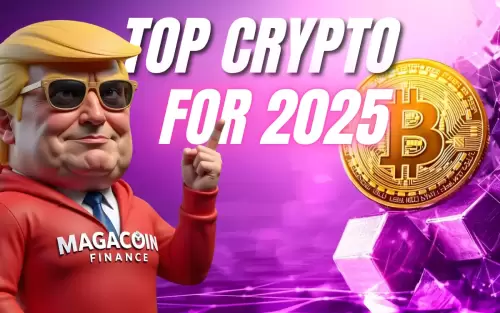 |
|
 |
|
 |
|
 |
|
 |
|
 |
|
 |
|
 |
|
 |
|
 |
|
 |
|
 |
|
 |
|
 |
|
 |
|
Cryptocurrency News Articles
The Tokenization Boom: Why Ethereum Remains the Rails for Real-World Asset Tokenization
May 08, 2025 at 11:01 pm

Thank you to our sponsor of this week’s newsletter, Grayscale. For financial advisors near Chicago, Grayscale is hosting an exclusive event, Crypto Connect, on Thursday, May 22. Learn more.
In today’s Crypto for Advisors, Tedd Strazimiri from Evolve ETFs writes about the evolution of tokenization and the value it brings to investors.
Then, Peter Gaffney from Inveniam answers questions about what tokenization can do for wealth managers and their clients in Ask an Expert.
- Sarah Morton
The Tokenization Boom: Why Ethereum Remains the Rails for Real-World Asset Tokenization
The tokenization of real-world assets (RWAs) has moved beyond buzzword status to become a multi-billion-dollar reality, led by Ethereum. Of the more than $250 billion in tokenized assets, Ethereum commands approximately 55%.
From stablecoins and U.S. Treasuries to real estate, private credit, commodities and equities, Ethereum has emerged as the preferred blockchain infrastructure for institutions aiming to bridge traditional finance with the digital asset world.
Why tokenization matters
At its core, tokenization is the process of converting ownership rights in RWAs into digital tokens that live on a blockchain. This transformation introduces unprecedented efficiencies in settlement speed, liquidity and accessibility. Tokenized assets can be traded 24/7, settled instantly and fractionalized to reach a broader range of investors. For institutions, tokenization reduces costs tied to custody, middlemen and manual processes, while offering transparency and programmability.
But while tokenization is a trend that can take root across multiple blockchains, Ethereum’s dominance is no accident. Its established infrastructure, widespread developer ecosystem and proven security have made it the go-to platform for major players entering the space.
Ranked: Blockchain Networks Supporting RWA Tokenization
BlackRock’s BUIDL and the rise of institutional tokenization
One of the best examples of institutional adoption of tokenization is BlackRock’s BUIDL, a tokenized U.S. Treasury fund built on Ethereum. Launched in early 2024, BUIDL allows investors to access U.S. Treasuries via blockchain, offering real-time settlement and transparency into holdings. The fund has rapidly scaled to over $2.5 billion in assets under management, securing a 41% market share in the tokenized U.S. Treasury space. Ethereum remains the dominant chain for tokenized Treasuries, accounting for 74% of the $6.2 billion tokenized US treasuries market. BUIDL isn’t just a product; it’s a signal that TradFi sees Ethereum as the backbone of the next financial era.
Stablecoins: the foundation layer
No discussion of tokenization is complete without stablecoins. U.S. dollar-pegged assets like USDC and USDT represent the vast majority (95%) of all tokenized assets. Stablecoins alone account for more than $128 billion of Ethereum’s tokenized economy1 and serve as the primary medium of exchange across DeFi, cross-border settlements and remittance platforms.
In many developing economies, like Nigeria or Venezuela, stablecoins provide access to the U.S. dollar without needing a bank. Whether shielding savings from inflation or enabling seamless international trade, stablecoins show the real-world value of tokenized dollars, backstopped by the Ethereum network.
Tokenized Stocks and beyond
Tokenized stocks on Ethereum represent a growing but still nascent segment of the tokenized asset space. These digital assets mirror the price of real-world equities and ETFs, offering 24/7 trading, fractional ownership, global accessibility and instant settlement. Key benefits include increased liquidity, lower transaction costs and democratized access to markets traditionally limited by geography or account type. Popular tokenized stocks include Nvidia, Coinbase and MicroStrategy, as well as ETFs like SPY. As regulatory clarity improves, tokenized equities on Ethereum could reshape how investors access and trade stocks, especially in underserved or emerging markets.
Additionally, real estate, private credit, commodities and even art are finding their way onto Ethereum in tokenized formats, proving the chain’s adaptability for diverse asset classes.
Tokenized RWAs (excluding Stablecoins)
Source: RWA.xyz, as of April 22, 2025.
Conclusion
Ethereum’s dominance in tokenized assets isn’t just about being first — it’s about being built for permanence. As the infrastructure underpinning real-world asset tokenization matures, Ethereum’s role as the financial layer of the internet becomes more pronounced. While newer chains like Solana will carve out niches in the space, Ethereum continues to be the platform where regulation meets innovation, and where finance finds its next form.
- Tedd Strazimiri, product research associate, Evolve ETFs
Ask an Expert
Q. What are the value drivers of tokenization for a wealth manager?
A. The tokenization of assets should come
Disclaimer:info@kdj.com
The information provided is not trading advice. kdj.com does not assume any responsibility for any investments made based on the information provided in this article. Cryptocurrencies are highly volatile and it is highly recommended that you invest with caution after thorough research!
If you believe that the content used on this website infringes your copyright, please contact us immediately (info@kdj.com) and we will delete it promptly.






























































